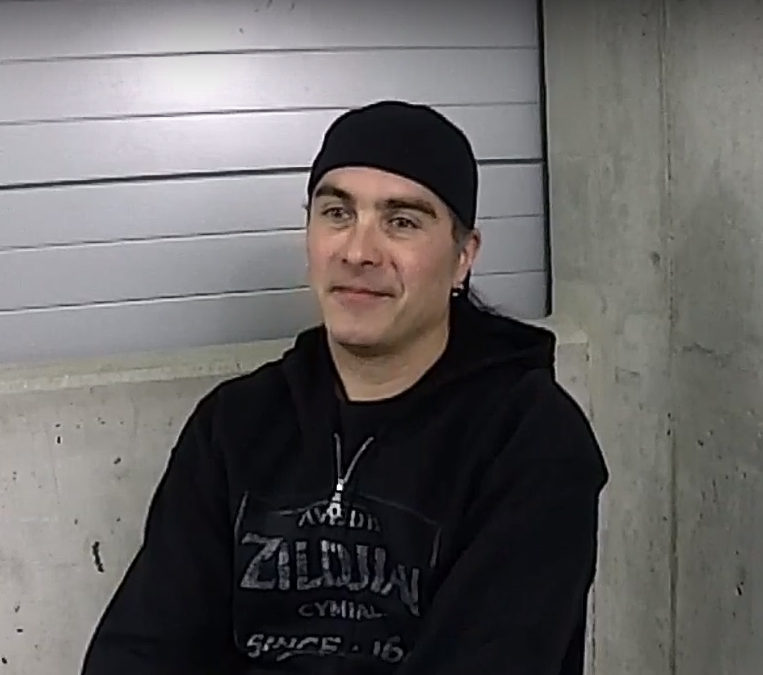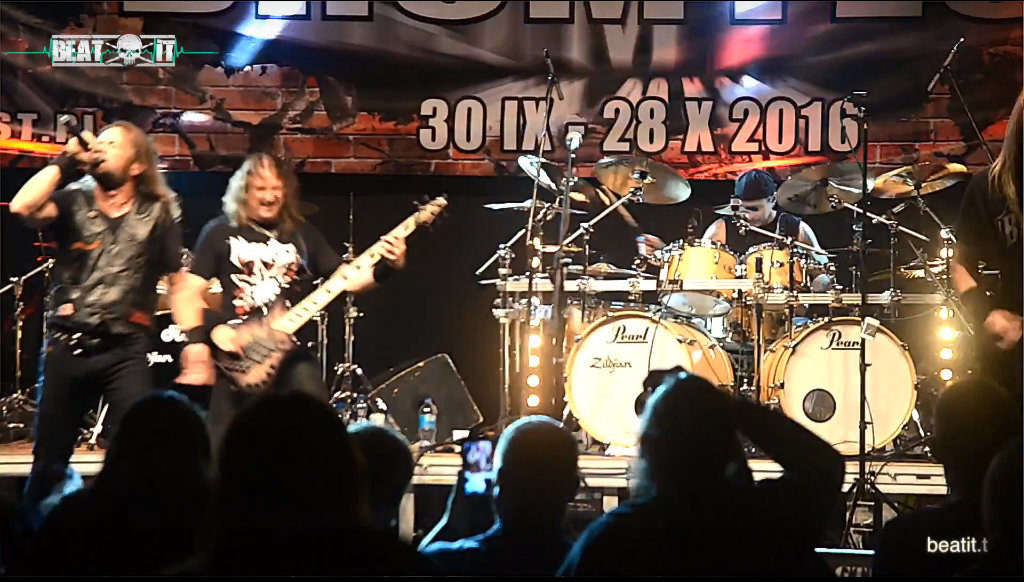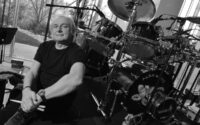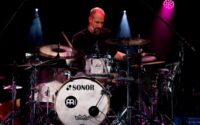During the 25th edition of the DRUM FEST Festival, which was held at the Conference and Exhibition Center in Opole, Poland, we met up with the drummers who participated in the event. They performed with their bands, conducted drum clinics and workshops, but also judged young Polish sitcksmen as part of the Young Drum Hero contest, which presented a very high level of playing.
Artists performing at the festival included the likes of Maciek Gołyźniak, Łukasz “Icanraz” Sarnacki, Katy Elwell, Jason Bittner, Jason Sutter, Rick Latham, Gary Novak, Kaz Rodriguez, Russell Gilbrook and, last but not least, Jason Bittner, who has worked with the likes of Marty Friedman, Shadows Fall, Anthrax, Flotsam & Jetsam (with whom he performed at DRUM FEST), and currently Overkill. Jason Bittner is endorsed by the following brands: Pearl, Zildjian, Remo i ProMark.
In the second part of the interview, our guest discusses the most important message he wants to convey with his clinics and the gear he uses on a day-to-day basis.
Jason Bittner in an interview for BeatIt, Pt. 2
BeatIt: What is the most important thing to convey to the audience when doing a clinic?
Jason Bittner: That’s a tough question to answer because it depends on the type of clinic it is, if it’s a full-on drum clinic, a masterclass, a drum performance at a festival or something. For this, I still don’t know how long I’m playing, I don’t know what they want me to do, there was no schedule until yesterday. So if I’m on a clinic tour, like, in stores. Let’s say I’m doing a 4 or 5-day run, I have a plan. I work it out at home, I know what I’m gonna do. I play 45 minutes, like, 4 or 5 songs, do a small solo and I usually ask the crowd if they have any questions. If they do then I address some of them. If not, I go: ‘Really?! You all came and nobody has a question? Could be as stupid as what did I eat for breakfast.’ I just want some kind of interaction with people because if I don’t get that, I’m like: ‘Ok, now what? Alright, I’m just gonna play.’ And maybe between songs someone wants to raise their hand and I’ll talk. If it comes to a point where no-one’s interjecting, I’m just gonna keep playing and treat it as a mini concert, kind of. The things that I like to convey with a clinic are: playing for the song, having fun playing drums and not making it a competition – not worry about who plays the fastest or how busy you can do this or whatnot. Also, the importance of being able to play other styles of music. I’m known for heavy metal, I’m a double bass drummer, that’s what I do best. But in my clinics, I play different kinds of music that I’ve done over the years with different types of bands to show the versatility level. It’s not that I’m gonna play jazz like Steve Smith does but the point is that if you have the basics of other styles of music, it makes you a more well-rounded player and doesn’t pigeonhole you as the rock guy. That’s the biggest thing that I like people to take away from my clinics ‘cause I think they see the other sides of my playing. They go: ‘I thought you just did this.’ I’m like: ‘I don’t.’ In Flotsam & Jetsam and before in Shadows Fall that is what did because that’s what the music called for. The same thing on the other end of the spectrum. If you’re jazz drummer, you shouldn’t be playing blast beats because they don’t belong in jazz, you know. It’ splaying for your situation and being able to have fun while doing it and not being so worried about: ‘Oh, I can’t play like this drummer or I can’t play like that drummer. As long as you can play like you, that’s the most important thing.
B: We know at least one jazz drummer in Poland who practises blast beats just for the heck of it.
J. B.: Right! And there’s nothing wrong with that! That’s my point. I’ve been told numerous times at my clinics when I’ve done more double-bass-centered clinics: ‘You know, I don’t play double bass but I found what you did interesting and now I wanna go learn.’ The one thing that I always talk about when it comes to double bass is that if your first foot is not together then you have no business trying to train your other foot, whether you’re a right-handed drummer or a lefty drummer. You need to know the fundamentals of playing drums with just a kick drum and a hi hat and being able to use the hi hat pedal. Too many young drummers nowadays just keep their foot on the hi hat or not even that. I’m always saying to my students: ‘Keep your foot on the hi hat. Keep that hi hat engaged, don’t leave your foot just being there dead. That foot needs to work. If, eventually, you’re gonna move to play double bass, if you’re already keeping time with the hi hat, guess what you’re gonna be able to do. You’re gonna be able to use the weak foot to play the other bass drum pedal.
B: Are you gonna use the exact same set tomorrow as you’re using tonight?
J. B.: Far as I know. Unless they tell me differently.
B: What’s your equipment for tonight and tomorrow?
J. B.: I’m finally back on Pearl drums after four and a half weeks of having to play a loaner kit that was not Pearl Drums. I’m not knocking other brands, I’m not knocking the brand that I used to play. That’s what I played for the last four and a half weeks because that’s what the kit for the tour was and that’s what I had to deal with but I find it funny that when I moved to the Pearl Family three and a half years ago… When I used to come over to Europe with Shadows Fall, I would get stuck with a Pearl loaner kit. Now, I go to Pearl, I come over and get a Tama kit. What’s going on in the drum universe here? I go to the right company now and I get a different company. They understand I had no call in that but it’s just nice that I’m back playing the stuff that I’m comfortable with and the stuff that I like. So today’s kit is a natural maple Reference Pure kit. It’s just plain and simple but it looks really nice. That’s not the type of finish I would pick personally but it’s a beautiful kit. 10, 12, 14, 16, two 22s, however, I’m only running a double pedal today instead of two bass drums. That’s only because I don’t have two single pedals with me. I had to use a double pedal for the European tour and only one bass drum so that’s what I was prepared to use. When I’m on a US tour next month, I’ll be using my new Music City Custom Reference Pure kit with both bass drums going. For today and tomorrow I have my trusted DW 9000 double pedal, fronted by all my beautiful Zildjian cymbals.
B: What are the models?
J. B.: Today, left to right, there’s a 21” A Custom Mega Bell Ride, a 17” K China, 17” A Thin Crash (which normally is a 17” Projection Crash), an 8” K Splash (normally, I run 8” and 10” Ks), a 17” Projection Crash (which is normally an 18” Projection Crash), an 18” Oriental China, 20” K Heavy Ride, 13” A Custom Mastersound hi hats on the right, 14” A Custom Mastersounds as a regular hat and a 19” K Dark Thin Crash is in the back. Most of those cymbals are the ones I would normally use, except my main ride is a 21” Z3 Custom Mega Bell Ride. It’s a regular Mega Bell but the cymbal itself is lathed down to half the thickness of a regular Mega Bell. I also use 18” crashes instead of 17” but sometimes with loaner cymbals you get close to what you normally use.
B: What skins do you use?
J. B.: Remo Emperor Clear on the tops, clear Ambasadors on the bottom, Powerstroke 3 on the kick and a CS Reverse Dot on the snare drum.
B: Sticks. Still your signature?
J. B.: Still my ProMark signature series 5BX. That’s been a staple since 2004, the Remos have been steady since 2007, Zildjian since 2011 and Pearl since 2013.
Drummers and Drummerettes! We give you Jason Bittner in the second part of an exclusive interview for beatit.tv!
Share








